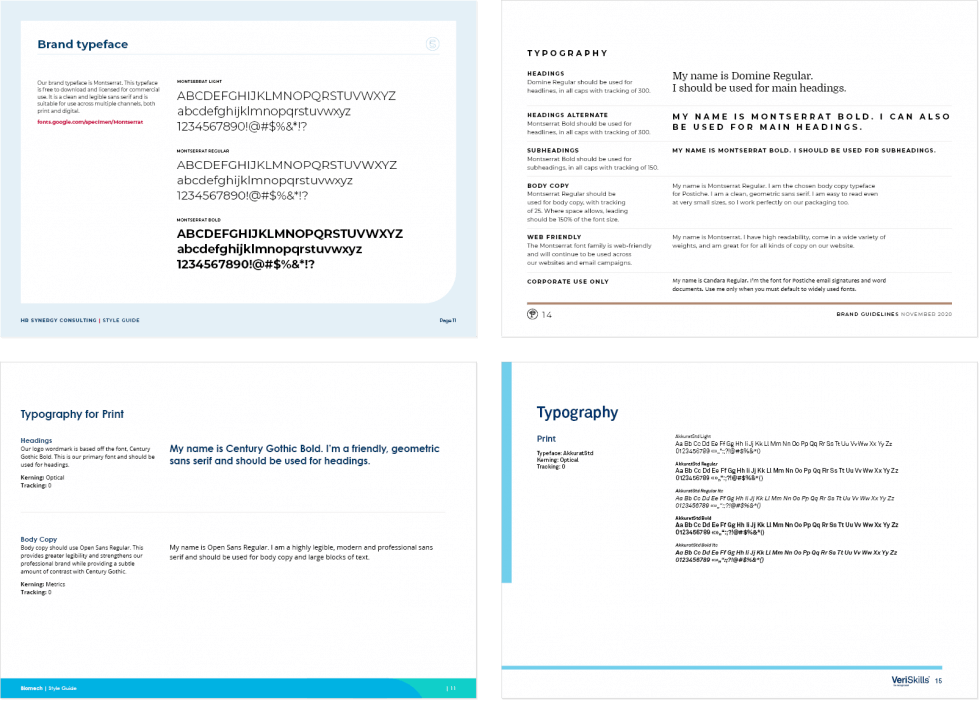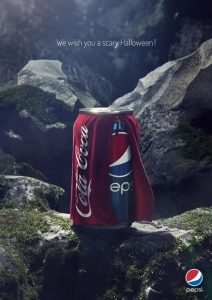
by fmadmin | Mar 10, 2021 | Design
Typography (noun.) the art or procedure of arranging type or processing data and printing from it.
As graphic designers are taught at college, “good typography is invisible, bad typography is everywhere”. Good typography should go unnoticed and work silently for your brand. Typography is the foundation of your brand identity, and just as colour, photography and tone of voice all influence how your brand will be perceived and remembered, so too does the style of your typography – so it’s vital that it is well-considered and meaningful.
Nail your typography from the start
When you’re building (or refreshing) your brand, your logo will underpin your entire visual identity. Therefore the typeface used in your logo itself should be well thought-out and capture the essence of your business. This is where we can help! Usually we will undertake a brand strategy workshop at the offset to define your unique brand personality and where your business sits on the personality spectrum – whether you’re traditional or innovative, exclusive or accessible, loud or sensitive. All of these factors will influence the chosen typeface(s). Graphic designers have the tools and knowledge (as well as an extensive library of typefaces to choose from!) to select typography that will best embody your brand. Additionally, when we’re crafting the type in your logo we will customise it by tweaking the kerning and leading, and/or adjusting the forms of the letters, to create a distinguished arrangement of type that is unique to your brand.
In some cases the type can be strong enough to form the logo in its entirety; this style of text-only logo treatment is known as a wordmark or logotype. Wordmarks are used by some of the most iconic brands in the world – think Coca Cola, Google or Disney.
What’s the difference between a typeface and a font? Oftentimes these terms are used interchangeably, but technically they’re different things. A typeface is the overall “font family” and is comprised of multiple fonts at different weights and styles. So for example, Arial is a typeface, while Arial Bold Italic is a font.
Consistency is key
After the time and consideration spent crafting a logo and brand identity and carefully selecting the typefaces that work best for you, these should be kept as consistent as possible and be used in your marketing and communications across the board. Once your brand has been refined and established we will create a style guide, and typography will of course form a key part of these guidelines.

Examples of various style guides created by Focused Marketing and the pages describing typography
Generally we will select one to three typefaces that are suitable for usage across print and digital channels. These typefaces should then be applied across all of your marketing collateral. Typography is at its strongest and most subtle when it is kept consistent and simple. Remember that the best typography should go unnoticed – it will subconsciously be absorbed by the consumer and just make sense. Using a random mix of typefaces across different aspects of your brand is a big no-no, as it will water down your overall image. Sticking to the designated typefaces helps reinforce your brand image, which in turn establishes trust and recognition.
Not all typefaces are web-friendly. In this case we will advise of an alternative font that should be used on your website. As part of the style guide we will also advise of a default system typeface that would be used for your internal communications only, ie. a typeface that all users can easily access as it comes pre-installed on all devices – but wouldn’t be used across any of your external marketing.
Just as in fashion or music, trends in typography come and go over time – but these shouldn’t bear a strong influence over the choices made for your brand. The best typography is relevant, timeless, and won’t look outdated or tacky when the trend fades away. The longstanding popularity of iconic and beautifully designed typefaces like Helvetica, developed in the 1950s, are a testament to this.
We’re experts in brand development and can help you harness the power of great typography – so if your brand is in need of a boost, get in touch.

by fmadmin | Feb 24, 2021 | Strategy
For our first blog of the year let us think about marketing foundations and talk positioning. Positioning clarifies your message so that prospective customers understand you. It enables you to really think about your brand’s value and how you communicate your value to your customers – a worthwhile effort we hear you say.
Talking about positioning can be challenging and we have met many a company that have never actually done it. To us it is essentially the most important building block of your company’s growth. Marketing positioning is not a brand statement; it is more about differentiation in your target market and clarity in your messaging. It is your why, what do you want to be known for?
So why do it?
Sitting down to work on your strategic positioning is all about focus. It will help you draw out your expertise, your distinguishing factor. It should enable you to focus your sales and marketing efforts on your specialisation.
Pin it down
B2B marketing is generally about getting to the details quicker. First you must understand the unique needs that companies you work with have and then appeal to their goals. Aim to describe your products and/or services, their unique attributes and advantages, and how your business helps other businesses in as few words as possible.
Make it stick
Simple psychology says that people remember one thing, not lots of things. Simplifying your message through clear positioning saves competing on everything all the time, being specific about what you do and why, and helps you become memorable for what you do best. Focus on subject matter and experience around your core business.
Positioning is not branding, although it is certainly about perception.
Feeling overwhelmed about strategic positioning? Drop us a line, we’re here to help. Over the past 14 years Focused Marketing has helped hundreds of companies map their future, so that everyone in the organisation is on the same page through activities such as positioning workshops and messaging audits.
by fmadmin | Dec 7, 2020 | Strategy
Feel like you’ve been in fight or flight mode all year? We get it!
The good news is it’s not too late for you to end the year on a positive career/business note. Follow our 12 Days of Christmas Calendar to set you up for success in 2021!
1. The work-changing magic of cleaning up
What better way to start the New Year than with a clean slate (or at least a clean desk and desktop). We challenge you to clear your desk, wash those coffee cups, clean your keyboard and empty those drawers and file those file-able things.
When your desk is looking like it’s from an IKEA catalogue, then tackle your computer desktop. That’s it, open those files and your dreaded downloads folder, and clean house!
2. Unboxing your inbox
Now that you’ve had a taste of digital decluttering, head to your inbox and be ruthless. Unsubscribe from those emails that no longer serve you, organise your folders, calendar and categories. Then delete or file the emails sitting in your inbox taking up precious space.
Why not set up some rules for next year to avoid the inbox overload? Oh, and don’t forget to schedule your out-of-office.
3. Get motivated
Choose a motivational book, podcast or course to complete before the new year or in the new year. Think of an area you’d like to build on, such as time management or a new skill that could help you next year. Think of the most effective way for you to commit to and learn – would a podcast on the commute to work be best or would you prefer to attend a class?
Whatever it is and however you do it, working on yourself is just as important as working on your business. Check out our free podcasts to learn a thing or two for the year ahead
4. Book that appointment
Book that appointment, use that voucher and attend that event!
Have a list of ‘should do’s’ laying around in your head? Or a soon to expire voucher? It’s time to conquer the list.
Looking after yourself shouldn’t be put off indefinitely, use this time to look after yourself or attend a networking event that you’ve been meaning to.
5. Jingle all the way online
Before the silly season starts, take a long sober look at your online presence. What message is your website and social media account portraying? Is it user-friendly and reflecting your business or personal branding? Or has it been neglected for too long?
Now’s the time to make sure your online presence shines in the new year and here’s where to get started.
6. Send Christmas cards and gifts – on time
Sometimes we enter the festive season with the best intentions – like buying Christmas presents before the mad rush and actually sitting down and writing those Christmas cards. Well this is the year to keep those intentions. It’s not too late to send your clients cards or e-cards but you need to get your skates on and if you need it we can help!
Think how much more you’ll enjoy the silly season if you can wear the smug smile of someone who nailed it this Christmas.
7. Try time blocking
If you feel the day is getting away from you, you’re fighting constant interruptions and are being pulled away in meetings, then it may be time to try a new way of working and take back your workday.
Time blocking is a time management method where you divide your day into blocks of time. Each block is dedicated to accomplishing a specific task and only that specific task.
Learn how to implement time blocking in your workday here.
8. New Year, new calendar
Too quickly do our months fly buy and we’ve forgotten to post on our socials or send out our eDMs. By creating your content marketing calendar for the year ahead, you’ll be able to stay on track (and kept in check) for getting your content out there regularly.
9. Discover pain points
The end of the year is a great time to reflect on what’s working and what isn’t. Is there a process that needs improving? Or something that your team is spending too much time on? Now is the time to get to the root of the problem.
List the pain points at work or in your business, dig deep and get other’s opinions as to sticking points in their day as well.
10. Brainstorm awesome solutions
Now that you have your list of pain points, it’s time to brainstorm some practical solutions.
Let all the ideas flow onto the paper before reviewing and editing what could work, how it will work and when it’s to be implemented.
Don’t forget to review the new process in a few months to see if it’s fixed your pain point.
11. Start dreaming again
You started your business or job with a dream. Whether it was to grow, earn more money, learn a new skill or have more work/life balance. Now’s the time to review if you’ve on the path to achieve those dreams or if you’ve got caught up in the day-to-day and missed the mark.
It’s time to dream big again. If this year has taught us anything, it’s that we’re a resilient and innovative bunch, so what have you got to lose by setting some big goals again. Make it happen.
12. Take a break
There, you’re all set to start 2021 organised, motivated and ready for success.
So now it’s time to switch off the computer, hang up the suit and enjoy time with your family, friends and fur-baby. Soak in some Vitamin D and remember why you work so hard in the first place.
Congratulate yourself on surviving a difficult year and recharge yourself to be ready for whatever 2021 will bring.
Merry Christmas and Happy New Year from the Focused Marketing team!
by fmadmin | Oct 27, 2020 | Content
There’s only one thing better than ogling at big brand marketing campaigns – ogling at THEMED big brand marketing campaigns! In the spirit of spooky season, we’ve rounded up some of our favourite Halloween themed campaigns.
KFC Australia – Cursed Colonel
In 2019, KFC Australia partnered with Menulog to add an additional menu item – ‘trick or treat’. Selecting this menu item meant that your order would be delivered by a Cursed Colonel; a driver dressed as a zombie version of the KFC icon.
Koala Mattress – A Ghoulish ‘Easter egg’
Everyone loves an Easter egg; that hidden piece of content or quirk that people have to really pay attention to notice. Koala used this concept and gave it a spooky spin by hiding a series of Easter eggs on their site in the form of some spooky photoshopping. Customers were tasked with identifying the correct number of spooky Easter eggs that had been added to the Koala website in order to win a prize.

Burger King – the ghost of McDonald’s
We have recently had the pleasure of watching the age-old Hungry Jack’s vs McDonalds battle play out on Australian shores with the introduction of the ‘Big Jack’ burger. This long-standing feud is always accompanied by some cheeky advertising tactics and it is a delight to watch it play out.
In 2016, a Burger King in Queens, New York dressed itself up as the ghost of McDonald’s with a sign on the billboard reading “Boooo! Just kidding, we still flame grill our burgers. Happy Halloween”. The home-made costume look even plays into Burger King/Hungry Jack’s default move of the underdog.


Chobani
Less cheeky and far more wholesome, Chobani ran a campaign with adorable pups dressed in Halloween costumes enjoying their yoghurt ‘treat’. Check out the not at all spooky video here!
Pepsi – risqué costumes
In similar form to Burger King, Pepsi ran a campaign in 2013 where they dressed up a Pepsi can in a Coca Cola ‘costume’ to “scare” viewers. Cheeky but effective!

by fmadmin | Oct 27, 2020 | Content
Owning a small business is pretty scary stuff, even prior to the woes of 2020. This Halloween, we investigate the frightening risks small to medium businesses have been facing over the years and how to get your haunted house in order for 2021.
1. Not accounting for grave times
According to the Australian Bureau of Statistics, half of all SMEs go bust in the first three years of operation, why? Well according to the Australian Securities and Investment Commission, poor cash flow is the cause of 40% of SME business failures. A rule of thumb indicates that a business should have liquid assets (i.e. cash in bank accounts and very liquid investments) equal to three to six months of their operating costs. While once this might have sounded excessive, it makes startling sense now!
Unprecedented global pandemic shutdowns aside, having a ready amount of cash on hand will help see you through slow trading times during the year.
2. Being unable to pay the ferryman
So, with cash flow the main issue effecting SMEs across Australia, it comes as no surprise that businesses aren’t being paid. In fact, according to The Invoice Market, there is $76 billion worth of outstanding invoices and two million businesses struggling with unpaid bills – pretty scary stuff. The Invoice Market’s SME Cash Flow Crisis Report shows that Australian businesses are constantly owed on average $38,000 each, with excuses ranging from ‘insufficient funds’ to ‘being reviewed internally’. Sadly, it’s a vicious cycle with 85% of debtors to Australian SMEs actually being other SMEs.
Worryingly, more than a third of Australian businesses have to cash in their own personal savings to deal with their business cash flow, impacting their ability to pay for essential living expenses such as rent and food.
3. Giving away all your candy
While a smaller issue compared to cash flow and mounting bills, but a common one none the less, is giving away control of your business’ important online assets. COVID-19 bought this to light with the urgent need to operate online and update websites and social media profiles, only to be faced with the realisation that many businesses don’t have access to these company assets. Business owners unaware of who is hosting their website (let alone the log in details), not owning their social media profiles and so forth, causes a lot of hassle, not to mention lost opportunity and time.
Now is the time to take back ownership of your online presence once and for all – ensure the details are found, the information corrected and stored securely to avoid this added stress.
SMEs are vital to our economy, employing 70% of our entire workforce in Australia. While running a business is not always fun and candy, the effect your successful business can have on our employment and economic recovery as a nation is actually pretty darn sweet.
Sources:
https://www.abs.gov.au/
https://asic.gov.au/
https://www.i-q.net.au/wp-content/uploads/Apollo_TIM_Report_2017_final-1.pdf







